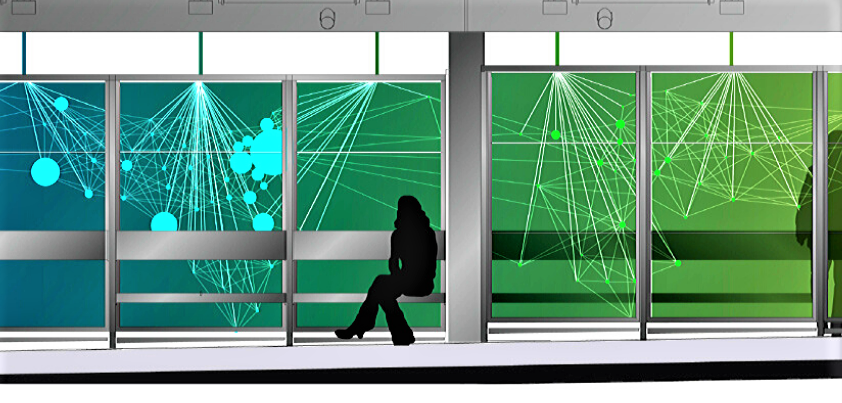Maryland Transportation Department Unveils Design Concept for Adelphi Road-UMGC Purple Line Station

Soon after construction on the station is complete, a work of art by Shane Allbritton and Norman Lee will be installed at the new Adelphi Road-UMGC-UMD Purple Line stop. The artists, co-founding partners of the Houston-based studio, RE: site, told University of Maryland Global Campus that while their data-based design has evolved during the lengthy submission and review process for the Purple Line Art-in-Transit Program, their concept has mostly remained the same.
Allbritton has connections to the national capital region. She was a senior graphic designer at Gallagher & Associates in Washington from 2006 to 2010. Years ago, well before the Purple Line project materialized, she and Lee had been selected to work on a project for the Washington Metropolitan Area Transit Authority’s Red Line. But that Metro project was scrapped.
Their involvement in the Purple Line project began six years ago when they responded in 2014—along with more than 700 others—to the Maryland Transportation Department’s call for art. They were among the 80 artists chosen to submit design concept proposals by a selection committee that included members of the Maryland Department of Transportation Maryland Transit Administration (MDOT MTA) and the Purple Line team; art professionals, representatives from the arts councils in Montgomery and Prince George’s counties and other communities across Maryland, representatives from the University of Maryland, and community members along the 16.2 mile project corridor.
The multi-stage selection process included opportunities for community members to attend public meetings where they could meet some of the artists and view and comment on their proposals, and designs were uploaded to a public website for further comment. The committee made its final selections in May 2017..
An Idea Takes Root
To begin concept development, the RE site duo took data they received from UMGC on the university’s student demographics, including headcounts by location in the U.S., Europe and Asia. Allbritton and Lee then used that information to craft a data visualization.
Detail showing the relationship between panels, sprouts and leaves scaled according to the student headcount by location, and the primary and secondary network of “roots” that connects students, UMGC locations and loosely defines continents
The concept behind the resulting graphic, titled “Germination: Global Campus + Growing Minds,” is literal and figurative—on one level an artistic presentation of the university’s size and scope, on another, an “organic” representation of UMGC’s import. The design consists of a series of glass panels covered with circles and dots depicting the volume of students at a given UMGC location.
But the focus of each panel is one “sprout” that connects UMGC locations through a primary “root” visualization. A secondary network of lines resembling thinner, fibrous roots connects UMGC student locations and loosely defines continents. There are also metal “leaf” structures, which are scaled relative to the headcount of students connected in each geographic location, according to the Re: site proposal. The organic whole of sprouts, circles, roots and leaves “reinforce the global community theme of the design,” the artists told UMGC.
Allbritton and Lee said their design is mostly finalized. They are working on the next phase—producing the files for future fabrication.
The Metro Authority created the purple line Art-In-Transit program to “make public art an integral part of the transit project,” according to literature provided to UMGC by Gary Witherspoon, a MDOT spokesperson. A wide variety of art is being incorporated into the features of Purple Line stations, too—fencing, canopies, windscreens, wayfinding, and platforms. The overall effect is designed to “enrich the aesthetics of the light rail system and support neighborhood identities.”
As described in the literature, the typical cost of the artwork is between $100,000 and just over $400,000, “The concepts were finalized at the end of 2018, although some are still being refined. We think that what we came up with reflects the best-of-the-best artists.”
About the cover image: This approximated visualization was composed for conceptual purposes only and accurate data is being developed for the final design. It is shown here by permission of the Maryland Department of Transportation Maryland Transit Administration.

Share This